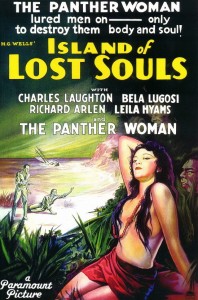TERROR! Stalked the Brush-Choked Island…Where Men Who Were Animals Sought the Girl Who Was All-Human!
There are times when the original take of a filmed version of a book is the best – actually in many cases this is true. One case in point is the powerfully wonderful 1932 film Island of Lost Souls, with [intlink id=”665″ type=”category”]Charles Laughton[/intlink] and [intlink id=”683″ type=”category”]Bela Lugosi[/intlink].
It is truly one of the best horror films of the era, though in truth it does have a bit of a Mysterious Island sort of feel to it. And as you would expect from a fine horror film studio like Universal- wait! Island of Lost Souls is actually a Paramount film. And this from a studio usually known for lighter faire during this period.
The film stars relative newcomer (at the time) Charles Laughton in the lead role of the devilishly mirthful Dr. Moreau, who on a secluded island has pushed the envelope of evolution several millennia forward. You see he has transformed animals into men. Or men-like beings.
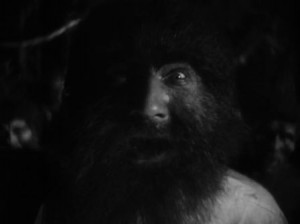 Most of those transformed don’t have large parts but are still magically relevant in their simple but evocative makeup. The leader of these men (again using that term loosely) if they have one is Bela Lugosi, portraying a character known only as the Sayer of the Law. He only has a few small scenes, but his interplay with Laughton on reciting the literally beaten in laws of mankind really steals the show.
Most of those transformed don’t have large parts but are still magically relevant in their simple but evocative makeup. The leader of these men (again using that term loosely) if they have one is Bela Lugosi, portraying a character known only as the Sayer of the Law. He only has a few small scenes, but his interplay with Laughton on reciting the literally beaten in laws of mankind really steals the show.
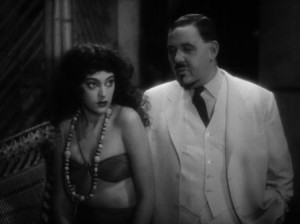 The other transformee of note is played by Kathleen Burke. This is Lota, otherwise known as The Panther Woman. I actually don’t recall her being called the Panther Woman on screen, but the film’s promotional signage refers to her as such. One cannot ascertain her feline ancestry except perhaps by her extremely pointed fingernails, which of course resemble claws.
The other transformee of note is played by Kathleen Burke. This is Lota, otherwise known as The Panther Woman. I actually don’t recall her being called the Panther Woman on screen, but the film’s promotional signage refers to her as such. One cannot ascertain her feline ancestry except perhaps by her extremely pointed fingernails, which of course resemble claws.
That being said, the star of the picture is Charles Laughton. He seemingly is too chubby, refined, and simply likeable to be the evil Dr. Moreau. Yet behind this mirthful exterior is a purely demonic man capable of all levels of pain and torment in his self titled “House of Pain,” where he performs his mad experiments.
Throwing a wrench in the Doctor’s plans is the marooned Edward Parker, played by the rather nondescript Richard Arlen. Parker is fairly stereotypical for the 1930s era hero and isn’t much to write home about. But while on the island he begins to get suspicious of what exactly is going on and- when his girlfriend appears on the scene to return him to civilization, they decide to take the plunge and escape to expose Moreau for what he is.
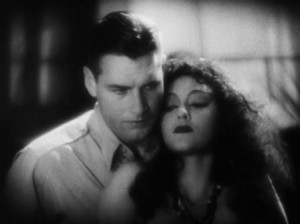 There is also a good twist to the plot whereby Moreau seeks to determine the depth of his success by attempting to mate the Panther Woman with poor Edward Parker. This is a nice twist and actually has a bit more on screen chemistry than the actual relationship of Parker and his girlfriend Ruth Thomas, played by Leila Hyams.
There is also a good twist to the plot whereby Moreau seeks to determine the depth of his success by attempting to mate the Panther Woman with poor Edward Parker. This is a nice twist and actually has a bit more on screen chemistry than the actual relationship of Parker and his girlfriend Ruth Thomas, played by Leila Hyams.
Sadly for ye olde Panther Woman, Kathleen Burke found herself, after winning a contest to portray The Panther Woman, typecast in the role. After two dozen films over the next eight or so years, she dropped out of the industry.
As an odd tidbit the film was- between the sexual pre-code undertones and the suggested dissections- found too intense for English audiences, and was banned in the UK until the mid-1950s. H. G. Wells himself was said not to be a fan and Charles Laughton claimed he could not visit zoos after he made the picture for the balance of his life- though Laughton was known to have a good sense of humor so the seriousness of the comment could be in question. Wells can at least be thankful that he missed some of the truly appalling versions of this which have been filmed over the years. This 1932 version is by far the best.
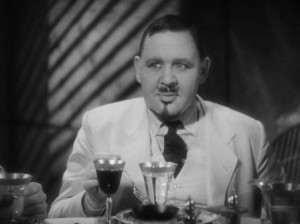 Of course there is a tremendous finale, which isn’t necessarily violent onscreen, but the cacophony of shrieks and noises of sheer pain- mainly heard from off camera- are still powerful today. It is surely a movie which hasn’t aged badly at all.
Of course there is a tremendous finale, which isn’t necessarily violent onscreen, but the cacophony of shrieks and noises of sheer pain- mainly heard from off camera- are still powerful today. It is surely a movie which hasn’t aged badly at all.
What makes the film more significant now perhaps was unintended- or at least unforeseen- by those making the film. Although some could (and perhaps should) make the case that forward looking folks such as H. G. Wells and Jules Verne did foresee a world in which genetic change or even could we say cloning would be possible.
Island of Lost Souls took along time to appear in either VHS or DVD format and for a long time was quite rare. It still isn’t the easiest to find, but thankfully has now been released as part of the excellent Criterion collection of DVDs. Highly recommended! The Criterion disc also features an upgraded print which obviously has had some level of restoration done to it as well.
In my book, this one definitely ranks with other classic horror films such as Dracula and Frankenstein. Perhaps better in some way due to the real potential applicability it has for us today.
